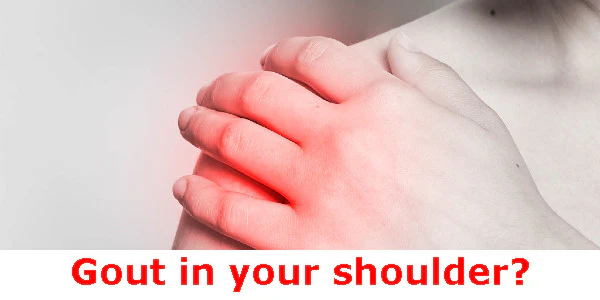Shoulder Gout & Uric acid : 5 Symptoms, Causes, and Effective Treatments-Unraveling Gout Guide
Table of Contents

Introduction:
This mechanism demonstrates that infection manifests no longer in well-known terms, along with a red, warm, swollen, gentle, painful, irritated, discolored, or immobile component, but additionally in gout. This inflammatory arthritis causes intense, sudden onset of ache, swelling, redness, and heat within the joint where deposits of needle-like, jagged uric acid crystals gather.
Shoulder gout, one of the more common forms of the disease, can occur in individuals with higher urate levels in the blood due to damage. For an individual, gout will happen when there are crystals in the system, and these can be drawn localized into a particular joint (as opposed to falling into some other location such as the foot or ear) and cause pain and inflammation in the area of the deposit.
Symptoms and Commonly Affected Areas
The primary symptom of Shoulder gout and hyperuricemia is a gouty attack—an acute inflammation of a joint or joints that makes itself felt suddenly, often at night. It most often attacks the big toe but can also attack the knees, ankles, wrists, and fingers.
Gout can cause severe and painful inflammation in the bursae (tiny, fluid-filled sacs surrounding and cushioning joints), tendon sheaths, and kidneys. https://www.hss.edu/conditions_gout-risk-factors-diagnosis-treatment.asp This may present as:
– Migraine in the temple
– Bouts of bursitis
– The inability of the affected limb to remain still
– Formation of pebble-like structures in the kidneys, or kidney stones with a pebbly consistency and rounded shape
- These kidney stones cause side pain, sneezing, and coughing.

Stages of Gout
- Hyperuricemia: Elevated urate levels without symptoms.
- Acute Gout Attacks: Intense joint pain and inflammation.
- Interval Gout: Symptom-free periods with underlying discomfort.
- Chronic Tophaceous Gout: Formation of tophi, hard urate lumps causing deformity and Shoulder joint damage.
Managing Gout
In general, treating first attacks of gout and shoulder gout involves early diagnosis with lifestyle interventions, including increasing urine output, avoiding purine-rich foods (such as meat and seafood), preferably with alcohol, and completely avoiding alcohol altogether. To reduce uric acid levels and effectively manage or prevent symptoms, doctors recommend using nonsteroidal anti-inflammatory drugs (NSAIDs) such as naproxen or indomethacin, along with colchicine and urate-lowering therapy like the xanthine oxidase inhibitor febuxostat. Maintaining a consistent exercise regimen and embracing a physically and mentally healthy lifestyle, including managing a healthy weight, are also essential.
Who Is at Risk?
The highest numbers of gout and shoulder gout sufferers are middle-aged men and postmenopausal women. Risk factors include:
- Hyperuricemia
- Family history
- Age
- Diet
- Alcohol consumption
- Obesity https://www.mountsinai.org/health-library/report/gout#:~:text=Gout%20usually%20occurs%20in%20men,drink%20large%20amounts%20of%20alcohol.&text=In%20the%20older%20age%20group,equal%20in%20men%20and%20women.
Diagnosis and Complications:
Such symptoms, along with positive blood tests, joint-fluid tests, and imaging, provide a diagnosis of gout, which – without treatment – is associated with hypertension, end-stage renal disease, and cardiovascular disease.
Gout/Uric Acid in the Shoulder: Initial Symptoms, Condition Origins, and Possible Treatments
Knowing the shoulder joint’s anatomy is essential to know what to look out for inpatients and their presentation.
Certainly! Here is a revised version of the text:
Similar to gout, recognizing the involvement of uric acid suggests that urate crystals can affect joint structures and contribute to the condition’s onset. Considering this, this article explores the anatomy of the shoulder joint, the prevalence of shoulder pain, the symptoms of shoulder gout, and ways to manage it.
Shoulder Anatomy:
It is not unexpected that the shoulder shoulder shoulder is a highly complex and mobile body part. It consists of several distinct components, including:
The scapula, a spiny bone in the upper chest
Surrounding muscles known as the deltoid and supraspinatus
The ball and socket joint that connects them all, along with many other parts
The Shoulder is composed of two main joints that form its structure:
The glenohumeral joint,
The acromioclavicular joint.
The Shoulder’s biomechanical performance depends mainly on the operation of its two principal joints. The glenohumeral joint is the ball-and-socket formed where the head of the humerus fits into the cup of the scapula and allows all the play seen there. The acromioclavicular joint is the joint formed where the clavicle meets the acromion, or little knob on the scapula itself, and where all the up-and-down and across-the-body function attaches.

Shoulder Pain:
Shoulder pain—bad enough to visit a doctor—is a leading complaint in primary and specialty medical practice, impacting tens of millions globally. Causes include everything from injuries and overuse to much less common entities like Shoulder gout, which is rarely a cause of shoulder pain but the most prevalent form of inflammatory arthritis, with its most considerable foothold outside the big toe.
Gout in Shoulder Joints: Its Presentation and Manifestation
While it is a comparatively rare site for gout, in individuals where urate crystals can form and accumulate in the bloodstream, it can cause a similar problem when they settle into the shoulder joints, causing acute tenderness, swelling, and inflammation.
The signs and symptoms of shoulder gout can sometimes be very similar to those of other joint conditions, potentially making it difficult to recognize as specific to gout (false-negative). Remember the following text:
Alternatively, clinicians may mistakenly attribute them to other causes of shoulder arthritis and shoulder injuries (false-positive). This presents a problem in clinical practice because the signs and symptoms of gout can mimic other shoulder problems (such as rotator cuff tear, joint injury, dislocation) and can also lead to confusion with shoulder bursitis, adhesive capsulitis (‘frozen shoulder’), or severe tendonitis. Seeing a healthcare professional, given the similarity of gout signs and symptoms with other shoulder problems, is a good idea. These symptoms usually start suddenly, are severe, and may occur at night. They include:
- Redness
- Swelling
- Warmth
- Severe tenderness around the joint
- Decreased range of motion in the Shoulder

Causes of Shoulder Gout:
Several causes can lead to shoulder gout, but it also occurs due to the presence of excessive uric acid in the blood. The underlying pathology involves hyperuricemia, which means elevated levels of uric acid, the chemical responsible for gout. When the body produces too much or releases too little, uric acid accumulates in the joint, forming crystals that cause inflammation.
One cause is overproduction of uric acid due to enzyme abnormalities or metabolic disorders, which increases susceptibility to crystal deposition in the joint, including the Shoulder.Increased serum uric acid signaled, perhaps, a ‘renal disease’ – other respectable causes – with which it probably coexisted, that increased its odds of gout, and the high purine-loaded diet (red meat combined with seafood) with some alcoholic drinks would increase the uric acid – and hence a patient’s risk of gout.
The management of shoulder gout is intensive and requires both normalization of urate as well as the control of pain and inflammation:
- NSAIDs: Nonsteroidal anti-inflammatory drugs (NSAIDs) relieve the acute pain and inflammation of gouty arthritis attacks. This class of drugs, which are readily available over the counter, is one of the most widely prescribed drugs for those who suffer from acute gout attacks by physicians.
- Colchicine: Once or twice if taken during a gout attack, this might be used to reduce symptoms.
- Long-term Drugs: Drugs that reduce uric acid throughout the body, including long-term medications such as allopurinol and febuxostat, can treat gout long-term.
- Xanthine Oxidase Inhibitors (XOIs) limit uric acid retention and deposition in tissues by helping the kidneys excrete more uric acid into the urine and inhibiting uric acid formation from other purine metabolites. Specifically, febuxostat blocks uric acid synthesis and prevents uric acid levels from rising.
- Uricosuric Agents: A uricosuric agent (such as the drug probenecid) helps increase the proportion of uric acid that the kidneys can excrete, thereby lowering blood levels and all of the crystallization risks that go with them.https://www.ncbi.nlm.nih.gov/pmc/articles/PMC5624445/
Lifestyle changes are also crucial:
- Reduce Foods Rich in Purines: Consuming fewer purines from foods might help prevent gout from returning.
- Weight Loss: Maintaining a healthy weight can reduce the risk of gout attacks.
- Reduce Alcohol Consumption: Limiting alcoholic drinks can help keep gout under control.
What are the symptoms of shoulder gout?
Shoulder gout symptoms include sudden onset of intense pain, swelling, redness, warmth, and reduced mobility in the affected joint.
What causes shoulder gout?
Shoulder gout is caused by the buildup of uric acid crystals in the joint, typically due to elevated uric acid levels in the blood from factors like diet high in purines, genetics, or metabolic conditions.
How is shoulder gout diagnosed?
Diagnosis involves a combination of symptoms assessment, joint examination, imaging (X-rays, ultrasound), and tests measuring uric acid levels in the blood and joint fluid.
What are the treatment options for shoulder gout?
Treatment includes medications such as NSAIDs (like ibuprofen), colchicine, and urate-lowering drugs (e.g., allopurinol) to manage pain, inflammation, and reduce uric acid levels. Lifestyle changes such as dietary modifications and weight management are also recommended.
Who is at risk for shoulder gout?
Middle-aged men, postmenopausal women, individuals with a family history of gout, those with obesity, and those who consume a diet high in purines and alcohol are at higher risk for shoulder gout.
What complications can arise from untreated shoulder gout?
Untreated shoulder gout can lead to recurrent gout attacks, joint damage, the formation of tophi (uric acid deposits under the skin), and an increased risk of kidney stones.
How can shoulder gout be prevented?
Prevention strategies include maintaining a healthy diet low in purines, staying hydrated, limiting alcohol intake, achieving and maintaining a healthy weight, and adhering to prescribed medications to manage uric acid levels.
CONCLUSION
Gout of the Shoulder is rare, but it can cause crippling pain when it occurs. Understanding its anatomy, presentation, and management helps comprehend its symptoms and provide appropriate relief for the patient. Prompt diagnosis and treatment can significantly reduce the severity of shoulder gout and its associated pain.

 +1987 123456
+1987 123456 info@example.com
info@example.com +9987 554855
+9987 554855
Leave a Reply